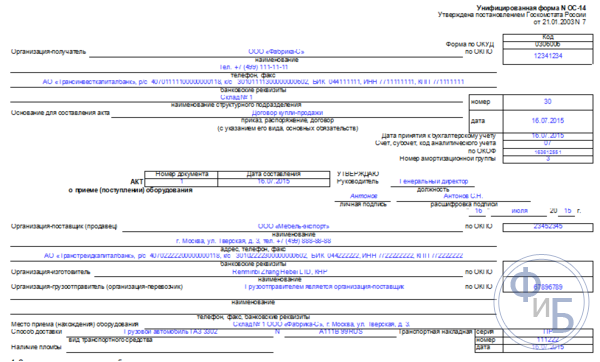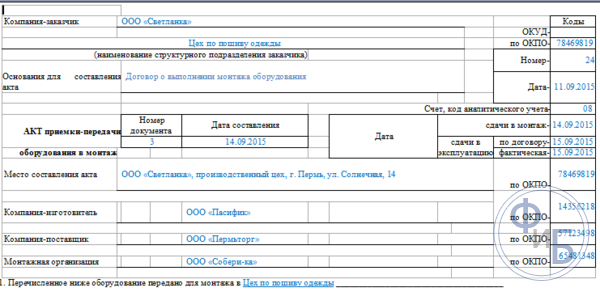A simple act of acceptance and transfer of equipment during the sale: a sample and a form + the procedure for the acceptance and transfer of equipment + useful tips on what to look for when processing documents
A simple act of acceptance and transfer of equipment for sale: a sample and a form is the topic of our today's review. The act of transfer is a mandatory document when registering the sale and purchase of assets of this kind. Usually, it is considered an annex to the contract of sale.
Such an act also serves as the basis for registering the equipment with the organization - the buyer and deregistration with the selling party. The act is drawn up by an authorized commission, which should include representatives of both organizations participating in the transaction. In addition, the commission may also include technical experts or specialists of the contracting installation organization, who can also put their signatures in the act and reflect their opinion in the conclusion of the commission. The act must necessarily reflect the presence or absence of technical malfunctions of the equipment at the time of acceptance.
Today we will take a closer look at how to draw up such an equipment transfer act, what rules exist when filling out a standard form, and how the equipment transfer process should generally take place.
Purpose of the act of acceptance and transfer of equipment
The act is intended to document the fact of delivery and acceptance of equipment, which will then be installed and put into operation, from one business entity to another. But this document allows you to reflect not only the fact of the transfer of equipment on a specific date, but also the state of the transferred objects. In the act, it is possible and necessary to record all malfunctions and damage to the equipment, its compliance with the characteristics recorded in the contract for the transferred equipment.
The act is an important title document and therefore can only be drawn up by a commission, which should include representatives of both parties to the contract, with the involvement of qualified technical experts, sometimes employees of the contractor that will install the equipment. If it is not immediately possible to draw up a qualified act for some reason, then a preliminary act is drawn up first.
The form of this act is standardized by the State Statistics Committee, this is the OS-14 form. When accepting the equipment, the acceptance organization must draw up such an act, in 2 copies, for each of the parties to the sale and purchase transaction.
The standardized form of the act consists of 2 sheets. At the top of the title page, the details of the parties carrying out the transfer and acceptance of equipment are indicated, followed by a table indicating the date and time of acceptance of the equipment. On the second sheet of the act form, in the tabular part, the characteristics of the equipment received are indicated, and in the lower part, the positions and names of the responsible persons who transfer and receive the equipment are given.
If, during the acceptance of assets, during its examination, significant defects were identified, then an additional defective act must be drawn up. The form of the defective act provides for the reflection in it of a complete list of all existing defects and equipment deficiencies.
Such an act on detected defects can also be drawn up after the acceptance of the equipment, for example, if defects were discovered during the installation or testing of the installed equipment.
After signing the act by all the boards of the commission, it must be endorsed by the chief accountant and approved by the head of the host organization, and only then the accounting department takes the equipment into account.
Standard forms of acts for the transfer of equipment
At the moment, there are three standard forms of transfer acts for equipment:
- Form OS-14, is used when accepting equipment to the warehouse. The act is drawn up and signed by a special authorized commission, consisting of employees of the parties transferring and receiving the equipment that entered into the sale and purchase transaction, as well as technical specialists. The act is drawn up in 2 copies, one for the buyer and the seller. The acceptance certificate is approved by the head of the organization.
- Form OS-15, is filled in when the assets are transferred for installation, if the installation work will be carried out by a third-party contractor. The representative of the contractor is a member of the acceptance committee, signs the acceptance certificate and receives a copy of the certificate in his hands.
- Form OS-16, is needed to reflect and describe all identified defects and equipment deficiencies. This act reflects all inconsistencies and disagreements between the party receiving and transferring the equipment, according to the technical condition or the quantitative composition of the transferred equipment.
It is also possible to draw up an act in an arbitrary form, if the agreement between the parties provided for special non-standard conditions for the transfer of objects.
The form sheet consists of two sheets. The title page is intended to indicate the details of the parties involved in the transfer and acceptance of equipment, the second sheet contains the details of the equipment.
On the first sheet, it is necessary to indicate the details of the parties transferring and receiving the equipment, the date and number of the act, as well as basic information about the manufacturer and carrier:
- Name of the recipient organization of the equipment;
- Phone number of the recipient organization;
- OKPO code of the recipient organization;
- Bank details of the current account of the recipient organization;
- The name of the structural unit of the organization where exactly the equipment came;
- The basis for drawing up the act is the Purchase and Sale Agreement;
- Name of the equipment supplier;
- Address, telephone number of the organization-supplier of equipment;
- OKPO code of the supplier organization;
- Bank details of the settlement account of the supplier organization;
- Name of the equipment manufacturer, indicating the country of origin;
- OKPO code of the manufacturer (if any);
- Name of the carrier organization and its OKPO
If the transportation is carried out by the supplier, then it must be indicated that the consignor is the supplier organization and its OKPO.

- Phone number of the carrier;
- Bank details of the settlement account of the carrier organization;
- Place of acceptance of equipment - name of the organization, its structural unit, address;
- Delivery method - type of vehicle (for example, GAZ 3302 truck) and its license plate;
- Details of the bill of lading - series, number and date;
- Indicate the presence or absence of a transport seal;
- Specify information about the place and time of acceptance of equipment - address, date and time of the beginning and end of acceptance;
- Number and date of drawing up the act in the form of OS-14;
- Date of acceptance of equipment for accounting (usually coincides with the date of acceptance);
- Account and sub-account number, depreciation group number, OKOF code, accounting serial number.

On the second sheet of the form, it is necessary to indicate data on the equipment received and on the commission that accepts it.
For the received equipment, the mandatory details are:
- Name;
- Manufacturer's serial number;
- brand of equipment;
- Unit of measurement;
- Type of packaging - in what packaging it arrived or without packaging;
- Number of seats or pieces sent;
- Weight;
- Cost per unit and total cost for this item;
- Number of seats / pieces and weight accepted;
- Were any defects found upon acceptance?
All the given characteristics of the equipment must be reflected in the tabular part of the act of this form. It is these data that make it possible to uniquely identify the equipment and avoid disputes.
When drawing up the act, the authorized commission must conduct a thorough inspection of the received equipment and record the following facts:
- Package integrity - damaged or not damaged;
- Completeness of delivery, indicate incompleteness if any;
- Give a conclusion on the acceptance and inspection of equipment.
Usually the standard conclusion looks like this: "Acceptance was made during external inspection, quality claims can be considered during installation." To reflect defects in incoming equipment, another standard form of defective act OS-16 is provided, which can be filled out some time after acceptance, since defects are usually detected during installation and commissioning of equipment.
If accompanying documents were attached to the equipment - technical passports or otherwise, this must be reflected in the act in the line corresponding to this.
Then, all members of the commission must sign this acceptance certificate, confirming that they are familiar with and agree with the results of the inspection of the equipment. The act must indicate the position, surname and initials of the persons signing it, as well as the basis of their authority (for example, power of attorney No. dated such and such date issued by the recipient organization). Separately, it is indicated the responsible person who accepted the equipment and now bears full responsibility for it, indicating the position of the surname and initials and his signature, as well as a document - the basis confirming his authority. Separately, it is necessary to indicate the person accepting the equipment for safekeeping, also indicating the position, surname, initials and signature of this person. The chief accountant of the organization must also endorse this act of acceptance. The head of the organization must approve the act by putting his signature on the title page.
The generally accepted standard form for the equipment acceptance certificate is no longer strictly mandatory, the parties can sign their own version of the certificate in any form. However, in order to exclude disputable situations, the act must still contain the characteristics of the equipment and the details of the parties to the transaction.
Details of the parties transferring the equipment and details of the transaction:
- title and date of the document;
- parties to the transaction - the name of the organizations transferring and receiving the equipment;
- the fact of transmission, its content;
- quantitative and cost estimation of transferred equipment;
- an indication of the positions, surnames and initials of the persons transferring and receiving the equipment, indicating the supporting documents confirming their authority, the signatures of these persons;
- document - the basis for the transfer of equipment.
The act must also indicate the place of acceptance - this will allow the receiving party to take into account the costs of transporting equipment.
In addition, it is imperative to indicate the details of the transferred equipment, which can uniquely identify it:
- name and model of equipment;
- factory numbers;
- manufacturer;
- year of issue,
- the number of places/pieces of equipment to be transferred;
- price.
Data on the technical condition of the equipment, date of issue, service life, wear, etc. can be entered into the act if desired.
In whatever form the act is drawn up, it is necessary to record the exact details of the parties and the main characteristics of the transferred equipment, as well as deviations in quantity or value, if any. Both parties must agree on the acceptance of the equipment and put their signatures, which will avoid controversial issues. The act must be signed by the chief accountant and approved by the head of the organization.
The information specified in the acceptance certificate is the basis for accepting the equipment for accounting, and this then affects the final reporting, both of the organization transferring the equipment and the receiving one. Note that according to accounting data, then taxation also occurs, which means that it will be very problematic to make corrections later.
At the time of the conclusion of the purchase and sale transaction, the parties accept the rights and obligations indicated in the terms of the contract. Delivery of equipment under the contract is confirmed by the acceptance certificate. When selling equipment, it is not enough just to bring it and unload it, an acceptance certificate must be drawn up, which is signed by an authorized commission specially for this. The commission may include invited technical experts. Upon acceptance, a thorough inspection of the equipment must be carried out, its technical check, test run must be carried out.

Acceptance of technically complex equipment can be carried out in stages. If at the time of delivery of the equipment it is not possible to carry out its thorough examination, then it is transferred on the basis of a simple inspection and verification of its compliance with the accompanying documentation. Then, first, a preliminary act is drawn up indicating that only a preliminary external examination has been completed. The final acceptance is issued after the necessary qualitative examination. In this case, at each stage, relevant acts are drawn up and signed indicating the activities carried out. At all stages of acceptance, the commission records the presence or absence of defects, compliance with the technical specifications stated in the sales contract. Compliance of the asset or non-compliance with the accompanying technical documentation. Absence or presence of breakdowns and the need for repair work.
Verification activities and signing of acts must be carried out in the presence of all authorized persons. There should be no corrections or errors in the acts. The act is drawn up with a mandatory indication of the absence or presence of malfunctions in the received equipment. Additional expert opinions, technical documentation, etc. may be attached to acceptance certificates. Signatures of all authorized members of the commission are put only when the acceptance process is completed and no one has any claims or disagreements regarding the transferred assets.
Properly executed acceptance certificates will help the buyer to take into account all additional costs incurred for the transportation of equipment, installation, repair, etc.
Note that, although there are legislative opportunities to use arbitrary acceptance certificates, standard forms are usually used, since they clearly indicate the main key points for the transfer of equipment. Correct and accurate filling of all the necessary positions of standard documents will allow you to avoid many controversial and conflict situations.
Along with the equipment, technical documents for it (registration certificate, etc.), as well as accompanying documents (consignment and transport waybills, etc.) must be transferred.
The signing of the act means that the asset is accepted on the terms and conditions specified in the sale and purchase agreement, in the technical condition in which the buyer undertook to transfer it under the agreement. The act of acceptance of the asset by the new owner gives the seller grounds to remove the asset from his account and formalize its disposal.
The standard form OS-14 is usually filled out during the initial acceptance of equipment and serves as the basis for acceptance for accounting. After the initial acceptance of the equipment, it can be sent for installation. If a representative of the contracting installation organization is a member of the acceptance commission, then he also signs the OS-14 act and then the OS-15 act can be omitted. If the equipment is transferred to the contracting installation organization later, then an additional OS-15 act is drawn up. If during the installation and commissioning of equipment defects are detected, then a defective act OS-16 is drawn up.

In addition, act OS-14 in practice is a document confirming the fact of acceptance of the equipment by the contracting installation organization, which accepts it for safekeeping for installation work.
The standard form of the act also allows you to reflect the receipt of equipment according to the supplier (weight, quantity) and the condition of the equipment actually received. The commission that conducted the acceptance must make its conclusion and this should also be reflected in the act. The act can be a general view of the equipment, its technical condition and the need for its repair.
The form of the act also provides for a clear indication of all responsible persons and the legitimacy of their actions.
Conclusion
The act of acceptance and transfer allows you to document the fact of the transfer of equipment from one business entity to another. In addition, this document can and should reflect the technical, qualitative and quantitative characteristics of the transferred assets according to the supplier and the actual state of the assets at the time of their acceptance. The act also reflects the technical compliance of the assets with the requirements specified in the sales contract, since this document is usually an integral part of it.
In the act, it is necessary to indicate the serial numbers and brand of the received equipment, check their compliance during the inspection. To draw up an acceptance certificate, it is better to use a standard form, since although it seems at first glance to be too detailed, it outlines the main points that need to be documented when accepting equipment. It is the data of this act that serve as the basis for the correct registration of new equipment, acceptance and validity of the associated costs incurred (transportation costs, repairs, installation, commissioning, etc.)
In the process of inspecting the equipment upon acceptance, a special authorized commission gives its opinion on the condition of the received equipment, its compliance with the declared technical characteristics. The commission includes members of both parties to the sale and purchase transaction, and third-party technical specialists may be involved. All members of the commission must sign the acceptance certificate and the general agreed conclusion, which can sometimes be a very important fact in case of controversial issues. In conclusion, we note that the act must be signed by the chief accountant of the host organization, approved by the director.




